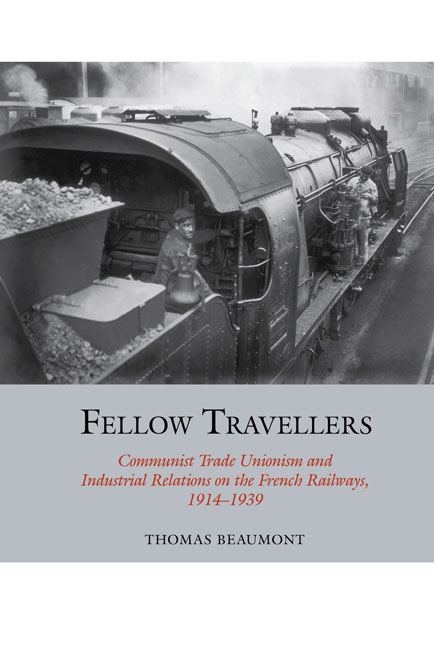 Fellow Travellers
Fellow Travellers Book contents
- Frontmatter
- Contents
- Acknowledgements
- Introduction
- 1 Railway Workers at War
- 2 Railway Workers and the ‘Après Guerre’
- 3 Railway Workers and the Communist Choice
- 4 Stabilisation
- 5 International Connections
- 6 ‘Hostile Participants’: Communists and Railway Industrial
- 7 Railway Workers and the Popular Front: From Victory to Defeat, 1934–1939
- Conclusion
- Bibliography
- Index
1 - Railway Workers at War
- Frontmatter
- Contents
- Acknowledgements
- Introduction
- 1 Railway Workers at War
- 2 Railway Workers and the ‘Après Guerre’
- 3 Railway Workers and the Communist Choice
- 4 Stabilisation
- 5 International Connections
- 6 ‘Hostile Participants’: Communists and Railway Industrial
- 7 Railway Workers and the Popular Front: From Victory to Defeat, 1934–1939
- Conclusion
- Bibliography
- Index
Summary
On the eve of the First World War, the French railway network was dominated by a handful of powerful private rail companies and one state-operated rail network. These regional railway companies, working from their headquarters at the major Parisian termini operated under conventions agreed with the French state in 1883. These companies were the Compagnie du Nord, which, as its name suggests, serviced the north of France; the Compagnie de l’Est; the Paris-Orléans (PO), which operated the railway network to the west and south-west of the country; the Midi; and the Paris-Lyon-Marseille (PLM), which ran services from Paris into the south of France. Added to this list was the state-operated Etat rail network, created in 1909 following the collapse of the Compagnie de l’Ouest. All told, the Grands Réseaux, as the private railway companies were collectively known, employed around 350,000 workers in August 1914.
Pre-war rates of union membership among the railway workers, collectively known as ‘cheminots’, were low and distributed among a number of individual trade unions. The defeat of the major railway strike of October 1910 had caused a significant collapse in union membership on the railways. From roughly 40,000 members in December 1910 this figure had fallen to just 14,000 one year later. The defeat of the strike left the workers deeply divided: between rival networks – workers on the Nord for instance felt that they had been badly betrayed by their fellow workers on the Est – and divided by hierarchies of skill. The largest of the unions representing railway workers on the eve of war were the Syndicat National, a general union which represented all grades of blue-collar workers, and the Fédération des Mécaniciens et Chauffeurs, the union representing the locomotive drivers and firemen. The latter were highly skilled workers who occupied the highest rungs of the blue-collar hierarchy on the railways. Pre-war efforts to unite the disparate trade unions representing railway employees had foundered, overwhelmed by the professional divisions within the industry whose complex hierarchies based upon type of profession and years of service created significant barriers between the various grades of cheminot.
After a brief flirtation with radical syndicalist practice, which culminated in the major national railway strike of 1910, the Syndicat National had moved steadily rightwards under the leadership of Maurice Bidegaray, a locomotive driver on the Etat network.
- Type
- Chapter
- Information
- Fellow TravellersCommunist Trade Unionism and Industrial Relations on the French Railways, 1914–1939, pp. 15 - 50Publisher: Liverpool University PressPrint publication year: 2019
